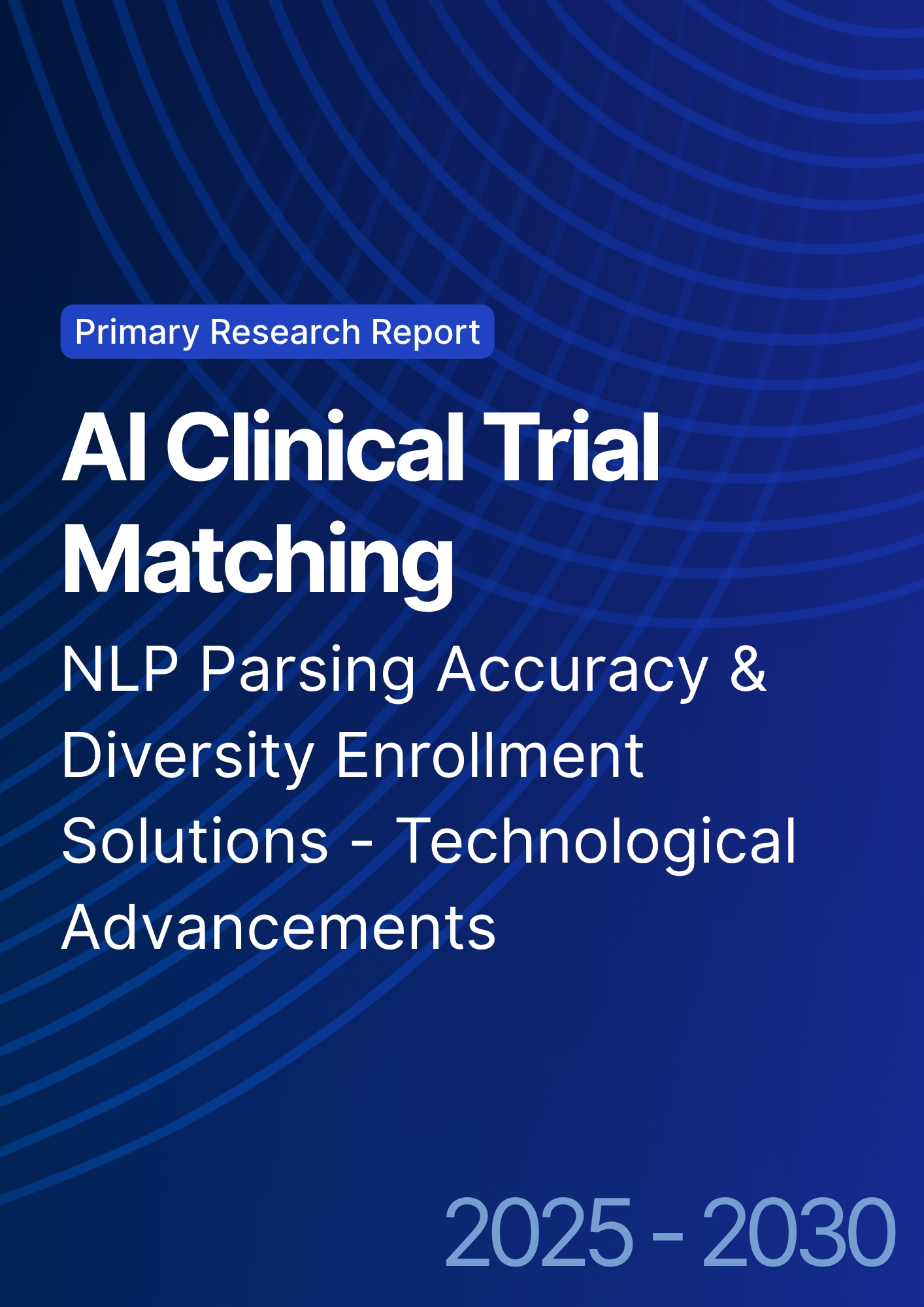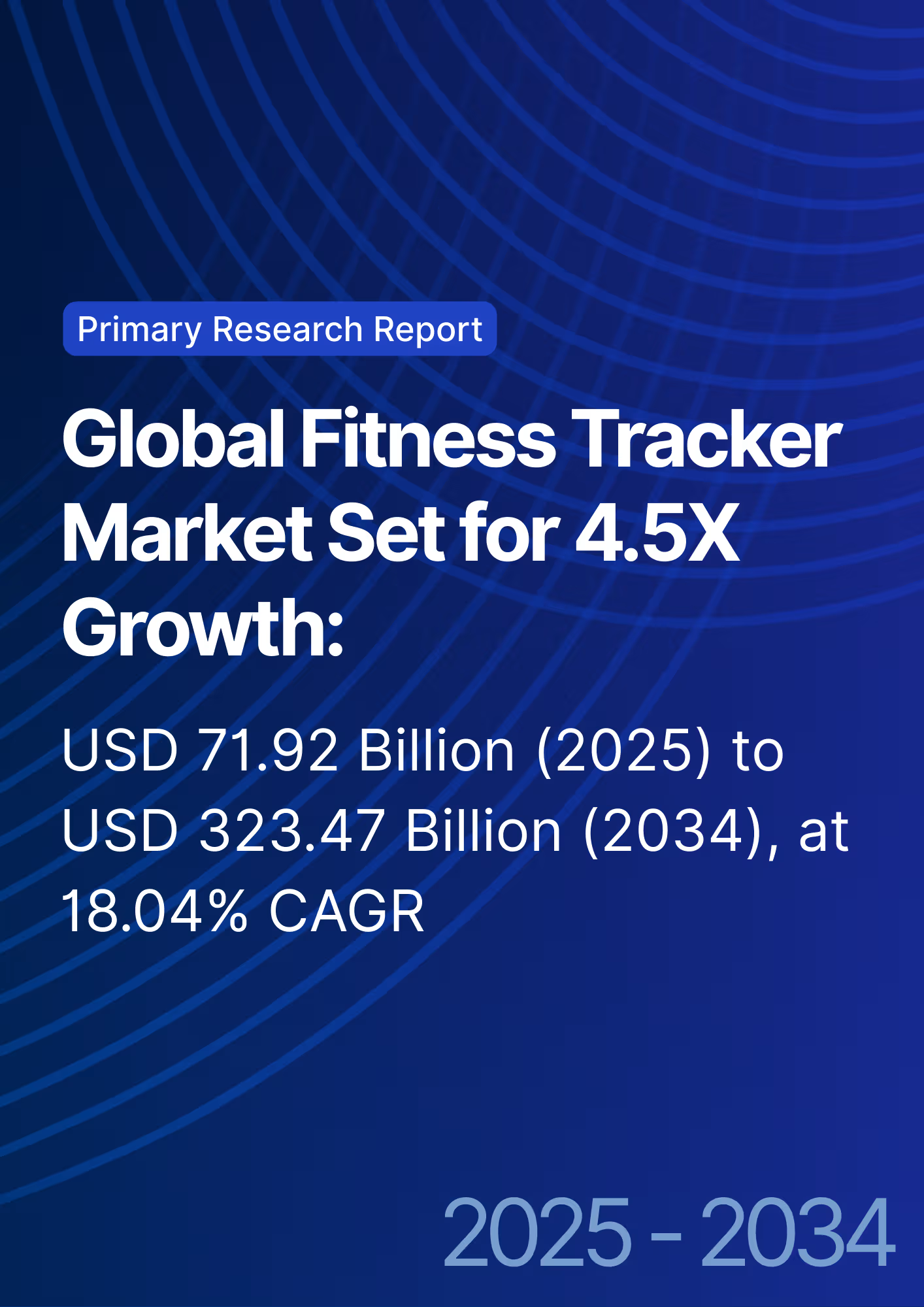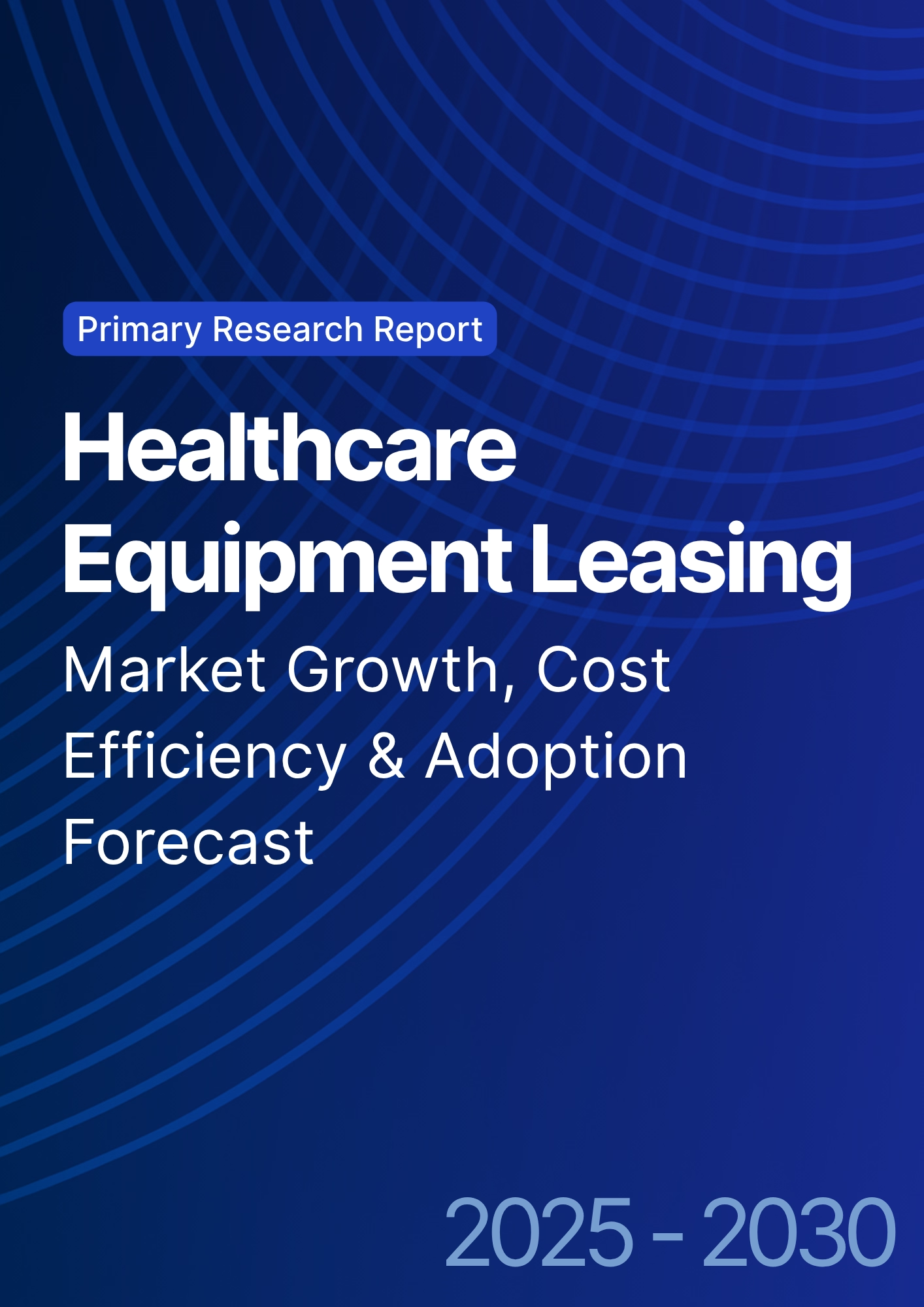

68 Circular Road, #02-01 049422, Singapore
Revenue Tower, Scbd, Jakarta 12190, Indonesia
4th Floor, Pinnacle Business Park, Andheri East, Mumbai, 400093
Cinnabar Hills, Embassy Golf Links Business Park, Bengaluru, Karnataka 560071
Connect With Us
AI Clinical Trial Matching: NLP Parsing Accuracy & Diversity Enrollment Solutions - Technological Advancements
This research explores AI-powered clinical trial matching systems in the UK and Europe (2025–2030), emphasizing natural language processing (NLP) accuracy, patient diversity in recruitment, and automation in eligibility parsing. It evaluates the market’s expansion as hospitals, CROs, and sponsors integrate AI for patient identification, consent optimization, and real-world data inclusion. The report quantifies accuracy gains, diversity representation metrics, and time-to-recruit reductions, guiding stakeholders toward ethical, scalable, and data-compliant AI deployment in clinical research.

What's Covered?
Report Summary
Key Takeaways
- AI clinical trial matching market projected to grow from €320 million (2025) to €1.9 billion (2030), CAGR 43%.
- NLP parsing accuracy expected to improve from 82% to 96% by 2030.
- Trial enrollment diversity (ethnic/gender representation) projected to increase 45% through AI recruitment tools.
- Time-to-recruitment reduction by 38% across sponsor-led trials.
- Data processing latency expected to decrease 60%, improving real-time eligibility scoring.
- Cost per enrolled participant to decline 30%, from €2,100 to €1,470.
- AI-integrated hospitals and CROs projected at 65% adoption by 2030.
- Regulatory compliance rate under GDPR and MHRA frameworks expected at 88%.
- Bias detection models expected to identify and correct 70% of skewed demographic data.
- ROI on AI clinical trial platforms projected between 20–28% by 2030.
Key Metrics
Market Size & Share
The AI clinical trial matching market in UK and Europe is projected to grow from €320 million in 2025 to €1.9 billion by 2030, representing a CAGR of 43%. Growth is driven by the integration of natural language processing (NLP), machine learning (ML), and real-world data analytics in clinical operations. By 2030, AI parsing accuracy is projected to reach 96%, up from 82% in 2025, significantly reducing mismatched patient profiles and protocol deviations. Trial enrollment diversity is expected to improve 45%, as AI platforms enhance representation across ethnicity, gender, and age groups through bias detection and inclusive recruitment algorithms. Time-to-recruitment is projected to decrease 38%, improving trial efficiency and reducing cost per enrolled participant from €2,100 to €1,470 (–30%). Hospital and CRO adoption of AI matching systems is projected at 65%, while regulatory compliance under GDPR and MHRA standards reaches 88%. The use of structured and unstructured EHR parsing enables faster eligibility assessment, shortening recruitment cycles from 14 weeks to 8.5 weeks. Bias correction algorithms are expected to identify 70% of underrepresented demographic gaps, enabling more equitable trials. ROI for sponsors and CROs is estimated between 20–28% by 2030, driven by faster recruitment, lower operational costs, and increased trial success rates. As clinical trials shift toward AI-first patient engagement, Europe’s regulatory and digital maturity provides a strong foundation for adoption and scalability.
.png)
Market Analysis
Between 2025 and 2030, AI-driven clinical trial recruitment platforms are set to transform patient matching workflows across Europe, growing at a CAGR of 43%. The integration of NLP and ML algorithms improves eligibility text parsing accuracy from 82% to 96%, minimizing manual screening labor. Diversity representation within trials will rise 45%, supported by automated bias detection models that monitor demographic imbalance in real time. The cost per enrolled patient will decline 30%, while time-to-recruitment will shorten by 38%. By 2030, 65% of hospitals and CROs will have implemented AI-driven matching solutions, supported by regulatory frameworks achieving 88% compliance with GDPR and MHRA guidelines. The ROI for adopters is projected at 20–28%, stemming from reduced administrative burden, improved recruitment precision, and faster trial activation. Operational metrics show that data processing latency will drop 60%, and eligibility misclassification rates will fall from 14% to 5%. The AI parsing ecosystem—including EHR connectivity, clinical coding ontologies, and consent analytics—enables seamless matching between patients and trial protocols. As healthcare institutions expand data-sharing partnerships, cross-border collaboration between UK and EU trial networks will rise 35%, further expanding recruitment pools. By 2030, the use of AI-based enrollment will be central to achieving faster, fairer, and more successful clinical trials across Europe.
Trends & Insights
The European market for AI clinical trial matching is witnessing a convergence of regulatory maturity, digital infrastructure, and AI model transparency. Market value is projected to reach €1.9 billion by 2030, at 43% CAGR. Key trends include increasing NLP parsing accuracy (82% → 96%), automated bias detection (70% correction rate), and enhanced diversity enrollment (+45%). These shifts are driven by the growing integration of electronic health records (EHRs), real-world evidence (RWE), and AI eligibility scoring. Recruitment cycles are projected to reduce 38%, with time-to-enrollment dropping from 14 to 8.5 weeks. Processing latency will decline 60%, enabling real-time candidate identification. Cost per enrolled participant will drop 30%, while regulatory compliance under GDPR frameworks will reach 88%. Cross-institutional data exchanges are expected to increase 35%, improving collaboration between the UK and EU. Meanwhile, AI explainability standards are becoming critical—by 2030, 75% of sponsors are expected to demand transparent model audit trails to ensure ethical AI use. Hospitals and CROs implementing AI-matching systems are projected to achieve ROI of 20–28% through improved speed, reduced attrition, and greater trial inclusivity. The combination of data-driven recruitment and policy alignment is positioning AI as a cornerstone for efficient, equitable, and regulation-compliant clinical trials in Europe.
.png)
Segment Analysis
The AI clinical trial matching market segments into pharmaceutical sponsors, CROs, hospital networks, and AI technology vendors. Pharma and biotech sponsors dominate with 55% market share, leveraging AI for multi-site trial acceleration. CROs account for 25%, adopting automation to streamline protocol screening and consent validation. Hospitals and academic medical centers hold 15%, focusing on AI-driven diversity outreach. The remaining 5% comprises AI vendors offering NLP engines, data anonymization, and patient-trial matching APIs. Parsing accuracy across segments is expected to rise from 82% to 96%, while bias correction will reach 70% effectiveness. Diversity enrollment is projected to improve 45%, with gender representation increasing 38% and ethnic inclusion 52%. Operational costs per participant will fall 30%, while time-to-match decreases 38%. Compliance rates will average 88%, ensuring GDPR alignment. Cross-institutional adoption is projected at 65% across Europe, with ROI between 20–28%. The UK, leading in regulatory sandboxes and NHS data accessibility, drives early adoption, while Germany and France focus on scalable integration via national health data hubs. Segment leaders—AI vendors and CROs—benefit from partnerships that combine NLP, real-world data pipelines, and automated EHR extraction, establishing the foundation for globally connected trial networks.
Geography Analysis
In UK and Europe, AI-driven clinical trial matching is expanding rapidly, reaching €1.9 billion by 2030, with the UK holding 40% share and the EU 60%. The UK’s NHS data infrastructure and regulatory sandboxes accelerate adoption, pushing NLP parsing accuracy to 97%, compared to 95% EU average. Time-to-recruitment reduction reaches 40% in the UK and 35% across EU nations, driven by improved EHR interoperability. GDPR compliance under AI-driven models is estimated at 88%, with ongoing initiatives to align AI Act regulations for medical research. Trial diversity will increase 45%, supported by inclusive datasets and targeted digital outreach. Hospital and CRO adoption is expected at 65% overall, but higher (72%) in UK health systems due to centralized data-sharing frameworks. Cost per participant will decline 30%, with ROI between 20–28%. Cross-border collaboration in AI matching projects is expected to grow 35%, especially through EU’s Horizon Europe program. Bias correction models will reach 70% accuracy, ensuring equitable trial representation. Collectively, the UK and Europe will establish the benchmark for AI-augmented trial recruitment, combining technological efficiency with ethical governance, redefining the speed and inclusivity of clinical research.
.png)
Competitive Landscape
The competitive landscape for AI clinical trial matching in Europe features CROs, AI tech firms, and data-platform providers. Leading players include Deep6 AI, Mendel.ai, Clinerion, and Trialspark, each leveraging NLP parsing engines and EHR integration APIs. By 2030, market consolidation will leave the top 10 firms controlling 65% of market share. Parsing accuracy improvements from 82% to 96% and data processing latency reduction of 60% will be key differentiators. Diversity and bias correction models with 70% accuracy will become a compliance requirement under the EU AI Act. CRO partnerships with technology vendors will dominate 25% of total implementations, while hospital networks adopt embedded AI tools via EHR integration. Cost per participant is projected to fall 30%, with ROI between 20–28%. GDPR-aligned AI audit frameworks will determine market leadership as regulators prioritize transparency and fairness. Firms with proven bias mitigation, traceability, and cross-border compatibility will capture the fastest-growing institutional clients. By 2030, AI-based matching will evolve from pilot adoption to a standard operating system for European clinical trials, emphasizing efficiency, inclusivity, and ethical automation.
Report Details
Proceed To Buy
Want a More Customized Experience?
- Request a Customized Transcript: Submit your own questions or specify changes. We’ll conduct a new call with the industry expert, covering both the original and your additional questions. You’ll receive an updated report for a small fee over the standard price.
- Request a Direct Call with the Expert: If you prefer a live conversation, we can facilitate a call between you and the expert. After the call, you’ll get the full recording, a verbatim transcript, and continued platform access to query the content and more.


68 Circular Road, #02-01 049422, Singapore
Revenue Tower, Scbd, Jakarta 12190, Indonesia
4th Floor, Pinnacle Business Park, Andheri East, Mumbai, 400093
Cinnabar Hills, Embassy Golf Links Business Park, Bengaluru, Karnataka 560071
Request Custom Transcript
Related Transcripts


68 Circular Road, #02-01 049422, Singapore
Revenue Tower, Scbd, Jakarta 12190, Indonesia
4th Floor, Pinnacle Business Park, Andheri East, Mumbai, 400093
Cinnabar Hills, Embassy Golf Links Business Park, Bengaluru, Karnataka 560071













